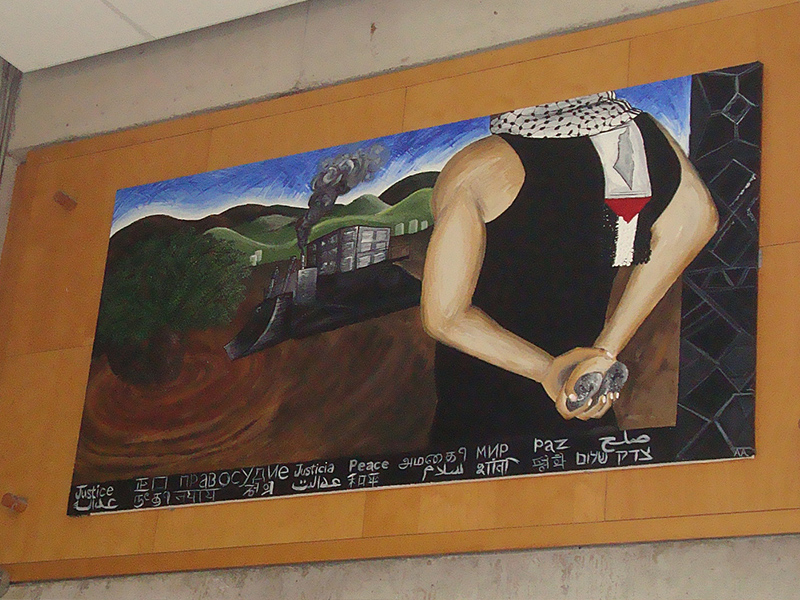Several years ago, a set of 20 murals were erected at York University in Toronto as part of a campaign to represent themes of student life, diversity, activism and social rights. Amongst the selected artwork was a painting titled Palestinian Roots, featuring a young man holding rocks behind his back and wearing a keffiyeh. He is watching a tree being bulldozed. Said to be inspired by the “ongoing issues in Palestine,” the mural also features words such as “Peace” and “Justice” in various languages. The map of Israel is embedded in the man’s scarf, except that in this map the land is labelled “Palestine.”
For years, I, like many, have been troubled by the demonstrable hate embedded in a mural that is ostensibly promoting peace. The artist’s desire may have been to show active resistance, but the image, which appears passive on the surface, has a more aggressive meaning. It depicts violence and aggression toward a population that has a right to exist as much as the next. The core message is not one of social rights, activism, and unity – it is, quite clearly, an attempt to target an entire religion and nation.
The map on the protagonist’s scarf is highly problematic. Israel is an established nation, a land and community that is not going anywhere. Jews have always had a claim to the land of Israel – the land we call home. Jerusalem has been the centre of this homeland for over 3,000 years. None of this can just be dismantled or erased from history books and maps.
Rather than suggest a solution, the painting ignores the right of Israel’s existence. It erases Jewish identity. Israel represents not just the promise of safety for the Jewish people, but also serves as the image of independence and hope during times of struggle. Following the anti-Semitic terrorist attack on the Tree of Life Synagogue in Pittsburgh, Jewish people and Zionists alike are looking toward Israel as an essential protection. Indeed, we honoured this tragic event with a vigil at the York University Hillel, and several members of the faculty, student body, and the Federation of Students attended to show their support.
So why can’t they see how the mural is terrorizing a community on campus?
How are Jewish and Israeli students supposed to feel about these mixed signals? How are students supposed to feel safe every day when they come to campus when they are met by a constant, daily reminder of hatred above their heads? And how can York University promote a policy and environment which celebrates diversity, activism, and social rights when the free speech of students who feel threatened is left unaddressed?
The 20 murals were meant to be displayed in the school’s student centre for two years. But today Palestinian Roots is still hanging in the York University Student Center.
It continues to represent the discontent and unwelcoming environment that Jewish students face on campus. It’s a major reason why Zionists feel uncomfortable on campus.
What other message can we be expected to take from a school where anti-Zionism is tolerated, if not supported, by the student government and university staff? We are witnessing on a daily basis an effort to erase a group of people.
READ: YORK U REVIEWS POLICIES IN WAKE OF MURAL CONTROVERSY
I believe in free speech, but this example of student activism represents violence against fellow students. I believe in the humanity of the student body, and I don’t believe that the university tries to actively be anti-Semitic toward its Jewish students. But this mural represents a hateful ideology – one that says Jews are not welcome, and neither are Zionists.
